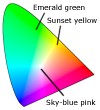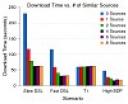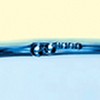A mash up between Chemrefer, the search engine for open access chemistry papers, and molecular structure search engine Chemspider launched today. I have to confess to playing no small part in facilitating this collaboration having introduced the Chemspider team, virtually speaking, to the owner of Chemrefer, Will Griffiths, who was a Reactive Profilee in June 2006. You can access the chemical mash up here. Search for any term of interest and the new hybrid tool will return all the pertinent results that are available for instant free access from the journal publishers. There are something like 50000 papers accessible this way via a search of more than 14.5million+ chemical entities.
Category: Technology
Tech Talk – Miscellaneous discussion of gadgets, industry, computer science, social media, AI
Open access medical records
 Fancy being a case report for medical scientists to ponder? If your answer to that question is yes, then you probably carry a donor card, regularly give blood, and have already willed your body to medical science. If the answer was no, then read on, the following may persuade you to if not donate your remains then perhaps make yourself a case in point.
Fancy being a case report for medical scientists to ponder? If your answer to that question is yes, then you probably carry a donor card, regularly give blood, and have already willed your body to medical science. If the answer was no, then read on, the following may persuade you to if not donate your remains then perhaps make yourself a case in point.
Medical case reports serve a vital role in medicine. Like those howto and self-help feature articles one sees in popular lifestyle magazines, they focus entirely on an individual patient, but at a slightly more technical level. Case studies provide unique insights into the rare side effects of new medications, early warning indicators of potential new diseases, unexpected associations between diseases or symptoms, and much more. Indeed, it was through case reports in the medical literature, that the earliest information on AIDS, Lyme disease and toxic shock syndrome emerged.
In recent years, however, economic and ethical pressures have led research journals to publish fewer and fewer medical case reports. The main pressure seems to be that such papers are of limited interest when read in isolation and more problematic from the publishers’ point of view are unlikely to be highly cited. Many research journals tout citation counts as a major selling point both to authors and subscribers, so poor-selling papers are unattractive to the marketing team.
The end result, is that a vast wealth of unique scientific data is simply lost.
Michael Kidd, Professor and Head of the Discipline of General Practice at the University of Sydney, hopes to change all that. He is founder of the open access (OA) Journal of Medical Case Reports. The OA approach taken by this journal means that medical case reports can find an audience regardless of citation concerns. By utilizing the OA publishing model, interesting case reports can reach the medical profession where previously they would simply sink without trace. With open access to this information, doctors can easily compare symptoms and treatments between patients and researchers and can sift through thousands of reports to formulate hypotheses and search for patterns and correlations. Who knows when the next AIDS or Lyme disease will emerge. Case reports might provide the first hints from the unfortunate “early adopters.”
How colourful language can improve your image
 Colourful language usually refers euphemistically to the kind of expletives and oaths you hear in a barrack room brawl. But, in the context of technology it could be the next big thing in colour printing.
Colourful language usually refers euphemistically to the kind of expletives and oaths you hear in a barrack room brawl. But, in the context of technology it could be the next big thing in colour printing.
Colour and natural language experts at Xerox have been working on what sounds like an entirely new way to get the best out of your digital photos. Their research could allow you to talk to your printer and tell it to “make the green a ‘mossy’ green” or “make the sky more sky blue”. More technically, you might one day be able to do all the kinds of colour and contrast corrections that are usually the preserve of programs like Photoshop, with simple phrases sent to the printer itself.
The approach speed up the workflow for graphic artists, printers, photographers and other image professionals and their assistants who could save time side-stepping the on-screen fine tuning process of printouts.
“You shouldn’t have to be a colour expert to make the sky a deeper blue or add a bit of yellow to a sunset,” research leader Geoff Wolfe says. The software is still in the development stages, but works by translating human descriptions of colour – “emerald green”, “brick red”, “sky-blue pink” – into the precise numerical codes printers use to control the amount of each primary colour they deposit at a single point in the printed image.
“Today, especially in the office environment, there are many non-experts who know how they would like colour to appear but have no idea how to manipulate the color to get what they want,” Woolfe adds. Moreover, the vast majority of computer screens in “non-expert” offices are setup incorrectly for screen to print comparisons and so cause the whole gamut of problems when a document that looks okay on screen is printed. Simple commands to rectify such issues avoid the problem of having to know how to set up the screen and ambient lighting.
Woolfe’s discovery could mean that colour adjustments can be made on devices like office printers and commercial presses without having to deal with the mathematics. For instance, cardinal red on a printer or monitor is really expressed by a set of mathematical coordinates that identify a specific region in a three-dimensional space, which is the gamut of all the colours that the device can display or print. To make that colour less orange, the colour expert distorts (morphs) that region to a new region in the gamut.
The ability to use common words to do this gamut morphing and adjust colour would have far-reaching implications for non-experts as well as graphic artists, printers, photographers and other professionals who spend a significant amount of time fine tuning the colours in documents.
“In the end it’s all about usability,” Woolfe adds, “Colour is so prevalent today, you shouldn’t have to be an expert to handle it.”
Open Access Abbreviated, Combined
 Just when you thought that the publishers had ran out of combinations of shortened discipline names – PhysChemOrgPhys, ChemCommPhysChem, CommPhysOrgGeoAstroChem (You know who you are!), BioMedCentral(!) is yet to launch another – PhysMath Central. PMC, an open access publishing platform, goes live today with a call for papers for its first journal is officially accepting papers for publication in its first journal, PMC Physics A, B, and C.
Just when you thought that the publishers had ran out of combinations of shortened discipline names – PhysChemOrgPhys, ChemCommPhysChem, CommPhysOrgGeoAstroChem (You know who you are!), BioMedCentral(!) is yet to launch another – PhysMath Central. PMC, an open access publishing platform, goes live today with a call for papers for its first journal is officially accepting papers for publication in its first journal, PMC Physics A, B, and C.
My former colleague on ChemWeb(!) Chris Leonard who is now heading up PMC tells me about why this endeavour is so important to the scientific community and publishing in general. “Global access to peer-reviewed research is as essential in the physical sciences as it is in the life sciences,” he says, “The same benefits apply, namely; increased readership, increased citations, decreased access barriers and the retention of copyright by the author.” Leonard is on record as saying that his move from the world of traditional publishing to the OA end of the spectrum represented an epiphany. “I started off at ChemWeb.com and subsequently moved to Amsterdam to work for Elsevier,” he explains, “I have now seen the light and am very happy to be developing physics and mathematics journals for the Open Access publisher BioMed Central.”
BMC explains the rationale behind the launch as being aimed at meeting the increasing demand for open access journals from major research institutes (such as CERN, the European Organization for Nuclear Research) and other funding organizations and government bodies. PhysMath Central could make research in physics, mathematics and computer science more widely available and increase access to this research to all institutes and individuals, without the burden of subscription charges. “The demand for open access is growing constantly as all scientists from all disciplines become aware of the benefits of open access publishing,” adds Leonard. Success will hinge, as with any new journal launch, on whether or not the putative authors feel the return on investment of submitting to the new journal will pay off in terms of readership and impact factor.
If the existence of yet more journals in the literature is not enough, PMC is also launching a blog, be sure to add it to your blogroll to keep up with developments and impact factor evolution. Oh, and one more thing, for their British authors: they deliberately missed off the “s” from “maths”.
Five times faster than BitTorrent
 Anyone who has dared to download, a large file using the Bit Torrent system in which chunks of the file are pulled from other BT users in a form of distributed file sharing will know how slow (and sometimes how fast) the method can be. Although much of the BT system is exploited to share pirated movies and music it has a serious, legitimate side that also allows scientists, engineers and programmers to share the burden of huge database and ISO image downloads. Now, thousands of US tax dollars (in the form of an NSF CAREER grant) have been spent on improving on the Bit Torrent system.
Anyone who has dared to download, a large file using the Bit Torrent system in which chunks of the file are pulled from other BT users in a form of distributed file sharing will know how slow (and sometimes how fast) the method can be. Although much of the BT system is exploited to share pirated movies and music it has a serious, legitimate side that also allows scientists, engineers and programmers to share the burden of huge database and ISO image downloads. Now, thousands of US tax dollars (in the form of an NSF CAREER grant) have been spent on improving on the Bit Torrent system.
David Andersen and colleagues at Carnegie Mellon University spotted the fatal flaw in torrents that often leads to the file sharing system grinding to a halt if the number of users with the complete or almost complete file are offline.
In conventional BT downloads, the files being shared must match exactly across the distributed sharing network or else they are ignored for download purposes. Anderson realized that identifying relevant chunks of files that may not be identical but are similar to a desired file could speed up Bit Torrent downloads. Anderson and his colleagues have designed Similarity-Enhanced Transfer (SET) to exploit this concept.
Anderson claims SET could make some transfers five times faster. “This is a technique that I would like people to steal,” Andersen said. Though he and his colleagues hope to implement SET in a service for sharing software or academic papers, they have no intention of applying it themselves to movie- or music-sharing services. “But it would make P2P transfers faster and more efficient,” he added, “and developers should just take the idea and use it in their own systems.”
SET works in a similar way to BitTorrent. Once a download is started, the source file is broken down into unique chunks. These chunks are downloaded simultaneously from accessible sources on the sharing network and then reassembled on the user’s computer. While this is underway, the SET program continues to search for similar files using a process called handprinting. In this method, sampling of non-identical files is used to find chunks that match the required chunks. Relevant chunks can then be downloaded from the similar files identified by this method, making the overall process much faster.
Although the researchers hope to use the SET approach for legitimate academic file sharing, they tested it on more common music and movie downloads. They saw a more than 70% improvement in downloading an mp3 file. A larger 55 Mb movie trailer was 30% faster when it could pull chunks from movie trailers that were 47 percent similar.
The researchers hope that such efficiency improvements will make SET part of the next generation of high-speed online multimedia delivery. “We believe that handprinting strikes an attractive balance for multi-source transfers. It efficiently locates the sources of exploitable similarity that have the most chunks to contribute to a receiver, and it does so using only a small, constant number of lookups. For these reasons, we believe that this technique is an attractive one to use in any multi-source file transfer system,” say the researchers.
How to produce static electricity with water
 Yesterday, we ran a video showing you a water powered battery that can generate a 15kV spark using nothing more than some simple hardware and a professor who looks a bit like Einstein. Some readers may have worried that it was a spoof given the date (April 1) but this is a genuine piece of science based on the principles of static electricity.
Yesterday, we ran a video showing you a water powered battery that can generate a 15kV spark using nothing more than some simple hardware and a professor who looks a bit like Einstein. Some readers may have worried that it was a spoof given the date (April 1) but this is a genuine piece of science based on the principles of static electricity.
Water is a polar molecule – there is a small difference in electric charge from one end to the other – but pure (deionized) water is also a very good insulator. As the droplets of water fall through the bottomless metal cans, their polarity induces a charge in the cans (which are by the way heavily insulated from earth (or ground). A positive charge builds up on the cans as the water molecules falling into the buckets become negative. This results in a charge separation or a potential difference between the paint cans and the buckets of water (which are also heavily insulated from earth).
Eventually the potential difference reaches a threshold at which point the insulating properties of the air between the two balls breaks down and a spark leaps across the gap. This spark, which has a temperature of several thousand degrees Celsius carries a voltage of between 10 and 15 thousand Volts, far more than you need to power even the biggest set of plugin speakers for your mp3 player.
Several questions remain. Where does the energy come from to create this enormous potential difference and could this form of electricity be tapped by building some kind of power station at the top of a waterfall and using two enormous cans and buckets? Well to answer the first question just look at the vertical arrangement of the equipment. The energy comes from gravity, from the potential energy of the water, which is above the paint cans. The second question is a little more complicated to answer. It would be possible to build a bigger generator, although insulating the components from earth would be tougher and the dissolved salts in river water would make it far less efficient than a generator using deionized water, but those are probably not the main issues.
Think about it, to make electricity generation useful we need a current to flow. How might you “tap” off a current from this type of generator when its product is effectively small-scale lightning? A capacitor in the spark zone, you say? But then isn’t the air acting as a capacitor, still doesn’t solve the problem of tapping off a current. Find an efficient and safe way to tap the power of lightning and you could make a fortune and solve the world’s energy needs. But, please don’t try those kinds of experiment at home!
Instead of generating static electricity, however, it is possible to use gravity’s power to move water to produce a current, much more readily…think water wheel, dynamo-type generator…think hydroelectric dam.
By the way, this experimental setup was originally devised by Lord Kelvin in the nineteenth century and is known as Kelvin’s Thunderstorm, it featured in Bill Beaty’s amateur scientist column in 1995, you can find a more detailed explanation there.
Water-powered mp3 Player
UPDATE: 31st March 2011 In hard times, humour is often all we have to lift our spirits. Given the current situation in Japan regarding the state of their nuclear power stations following the tragic and devastating earthquake and tsunami, a twitter follower, Christophe Shiffert thought this electric sweet potato funny enough to tweet about it and to allude to the constantly unfolding tragedy that is humanity’s failure to address the problem of energy in more creative and sustainable ways.
In this week’s video, MIT’s Walter Lewin demonstrates how to produce 10 to 15000 volts of electricity using a couple of empty paint cans, a bucket of water, some wire, and two balls. The question is how does this work and could you use it like the potato powered mp3 player?
I’ll look forward to seeing your suggestions in the comments and will post a more detailed explanation the the answers tomorrow.
Free software shows how drugs work
 If you are already a user of free chemistry drawing package ACD/ChemSketch but need a little more physical information from your tools than simple structure drawing, then ACD/Labs’ latest freebie might be right up your street. They just released ACD/LogP, which can be used to extract a lipophilicity prediction from your structures with a few mouse clicks.
If you are already a user of free chemistry drawing package ACD/ChemSketch but need a little more physical information from your tools than simple structure drawing, then ACD/Labs’ latest freebie might be right up your street. They just released ACD/LogP, which can be used to extract a lipophilicity prediction from your structures with a few mouse clicks.
For those not in the know, logP, is the octanol-water partition coefficient and is a useful value assessing how a putative drug might partition between cell membranes and cellular fluids. It gives you an indication of potential oral availability in other words. This allows drug designers to find out early on whether they will need to do additional work to make a compound available by mouth.
logP isn’t only about drugs though, agrochemists can use it to help them predict how their experimental compounds might partition between different species. This allows them to see whether a compound might target particular pests in preference to beneficial insects, for example.
This property is also useful to flavour and fragrance scientists who can judge in silico how a new compound might behave when added to food or dabbed on the skin as perfume.
ACD’s physical chemisty products manager Greg Pearl explains that making logP available to the community for free will not only support research but will help students and educators get to grips with this important property. ‘Freeware is especially valuable to educators and students with limited resources,” he says. “For example, during a lecture, an educator can interactively demonstrate how subtle changes to a molecule changes it physical properties – much more compelling than discussing a table of numerical results. It also gives students a chance to use the types of tools they will encounter in the workplace.’
“Through this release of ACD/LogP freeware to scientists worldwide we continue our tradition of advancing chemical research by making critical physicochemical properties available to scientists in an open-access environment,” Pearl adds. “Users will benefit from over a decade of algorithm refinement resulting in accurate and reliable predictions.”
Just for the record, ACD/Labs hosts the Reactive Reports chemistry webzine. There’s more information about logP on their site here
Chemical pipe works
 Mitch Garcia of UC Berkeley seems to be far more expert with the latest web 2.0 tool that lets you produce your own search algorithms than I, so I asked him to look into creating a Yahoo Pipe to allow anyone to search as many chemistry journals as possible that offer ASAP and in press papers online. And, much kudos to him, he has done just that. Here’s chemistry journals search pipe. He explains the process and the limitations in a little more detail on his own blog.
Mitch Garcia of UC Berkeley seems to be far more expert with the latest web 2.0 tool that lets you produce your own search algorithms than I, so I asked him to look into creating a Yahoo Pipe to allow anyone to search as many chemistry journals as possible that offer ASAP and in press papers online. And, much kudos to him, he has done just that. Here’s chemistry journals search pipe. He explains the process and the limitations in a little more detail on his own blog.
Give it a try and let us know what you think. What makes this tool totally tubular is that once you’ve run a search using a pipe, the results are their own RSS feed, which means you can subscribe to the results with your news reader (My Yahoo, Bloglines, Google Reader etc). Even more intriguing is the idea that you could presumably then use that feed as the basis for creating an even more sophisticated Pipe of your own.
For instance, this feed displays the results from Mitch’s Pipe searching all those chemistry journals for the word greenhouse. It’s quite unlikely that there will be any gardening papers in the ACS, RSC or Wiley chemistry journals, so you can be fairly sure that this feed will bring you the latest papers on greenhouse gases and their effects. Combine that with a feed for global warming, and one for climate change, and you should have the niche covered.
Orders of magnitude
Strangely, the phrase “orders of magnitude” featured in a visitor’s search efforts while browsing the sciencebase site. Unfortunately, other than using the phrase myself in the context of, for instance: “the amount of greenhouse gases emitted by human activities is several orders of magnitude smaller than those emitted by natural processes”. I did not actually have a definition of orders of magnitude on the site. Until now. So here goes:
The order of magnitude is the scale of any given amount where each class contains values of a fixed ratio to the class preceding it. The ratio most commonly used is 10. For example, a kilogram is three orders of magnitude bigger than a gram.
In the greenhouse gas instance cited above, the phrase “orders of magnitude” is simply being used colloquially and can apply in many situations, such as the volume of water in the Pacific Ocean is many orders of magnitude greater than that contained in Lake Michigan. To give a more solid example, one might say “An order of magnitude difference between two values is a factor of 10. For example, the mass of the planet Saturn is almost 100 times that of Earth, so Saturn is two orders of magnitude more massive than Earth.
Orders of magnitude are not always on the decimal scale. For instance, the difference in size between a megabyte and a gigabyte is three orders of magnitude, but the multiplier is 1024 rather than 1000. Please correct me if I’m wrong on that, I guess you could define a single order of magnitude her as being based on 1024 rather than “10”.
More on order of magnitude here.